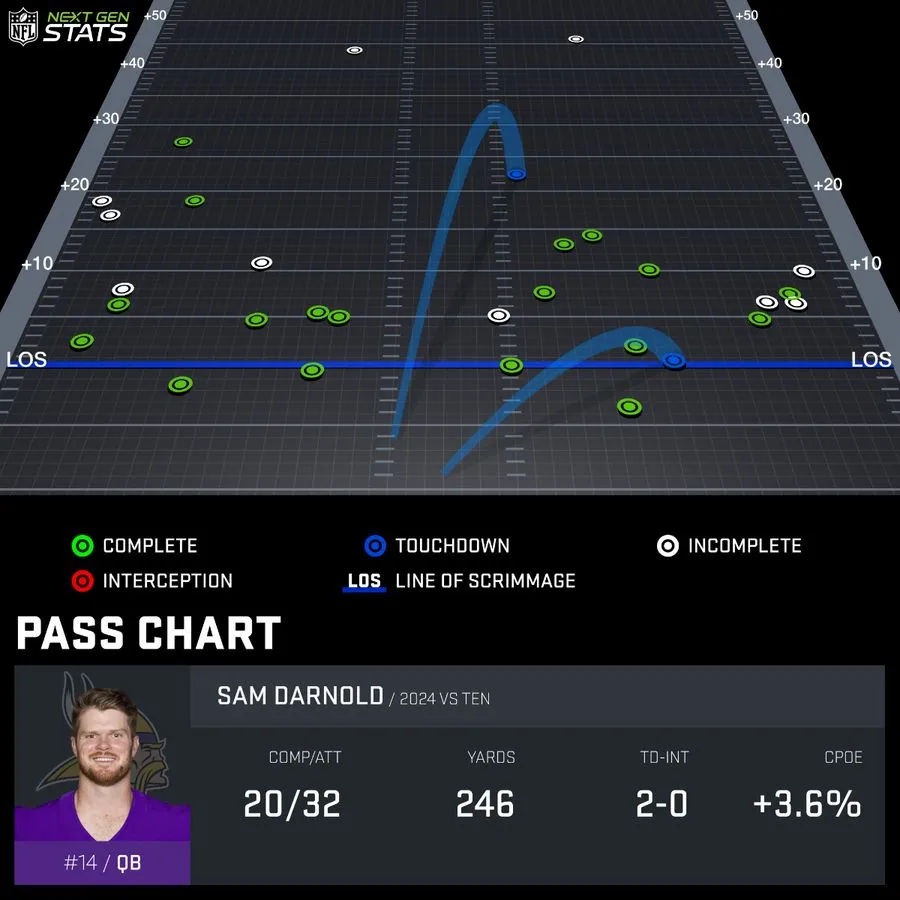Post by Purple Pain on Nov 18, 2024 11:59:41 GMT -6
Arif Hasan: Minnesota Vikings Smother Will Levis and the Tennessee Titans to Advance to 8-2
Offense Does Just Enough

There has been some concern about Sam Darnold, whose performance wasn’t nearly as alarming last week as the interception numbers suggest. Darnold’s down-to-down performance is still much better than most quarterbacks in the league and we saw what that looks like in this game against the Titans.
With Justin Jefferson drawing additional attention on coverage assignments again, Darnold was able to exploit the space available for Jordan Addison and Jalen Nailor to create great throws. Though Nailor didn’t pay back those throws with big plays, the net result of Darnold’s more open approach this week was a solid 7.7 yards per attempt with two touchdowns and no picks.
It was a surprising performance from the receiving group, and they totaled around five drops in this game, meaning that Darnold was accurate enough to produce a completion on 83.3 percent of his throws despite an average depth of target of 10.0 yards downfield.
That’s remarkably consistent play. He also happened to do it while doing a better job controlling the pocket. While it’s important to credit the offensive line for their significant role in keeping the pressure rate low – below 25 percent – Darnold’s decisive play also obviated pressure when it arrived.
His escapability was also essential to keeping the Vikings on schedule, and his ability to persistently produce positive plays – he finished with a success rate of 54 percent despite suffering from five receiver drops – meant that the Vikings were always a threat to score.
On the receiving end, we saw another “quiet” game from Justin Jefferson where he nevertheless produced more than 80 yards. This week, it was an 81-yard outing with another 21 yards in penalty production.
When including induced DPI penalties — but not the holding or illegal contact penalties — Jefferson entered the game with 895 produced yards, second in the NFL. Now, with 992 such yards, he won’t catch up to Ja’Marr Chase this week, but the race in produced yards per game gets closer as Chase plays on Sunday night against the Chargers.
Before the final statistics from the Chargers game get totaled, Jefferson is at 99.2 produced yards per game and Chase is at 100.8.
Once again, the 23 points were not a judgment on his ability to produce offense but rather on some elements of the supporting cast, including Aaron Jones.
This is a game Jones will want to put behind him. A fumble on an exchange – officially credited to Darnold – and another, thankfully recovered, meant his performance would have been a negative even if he had had a great day running the ball.

He didn’t, unfortunately.
Starting Dalton Risner over Ed Ingram was likely a big reason the Vikings had a low pressure rate on their passing dropbacks. But Risner is a poor run blocker and that showed up in this game. Cam Robinson’s inconsistency in that area didn’t help either.
Even acknowledging some poor run blocking, a problem that didn’t affect the whole offensive line, Jones didn’t play with the same decisiveness or agility. Late in picking lanes and not as powerful shedding tackles, the Vikings couldn’t get much going in the run game. They finished averaging 2.5 yards per attempt.
This is not purely a product of short-yardage runs, either. Their success rate on runs, just 35 percent, was one of the lowest success rates we’ve seen for the team this year.
The Vikings should hope to put more points up against a team like the Titans, especially given their injury issues at cornerback. But that wasn’t a Darnold issue – he played excellent football. Instead, the elements that we trust a bit more – the receiving group, the running back and, to some extent, the offensive line – were greater limiting factors.
The Vikings no longer aspire to be “good enough”; their goal is to be a legitimate playoff threat. With that in mind, a lackluster performance against a bottom-level team like the Titans might engender some worry. But the Vikings played better than it seems, and that should bear out.

There has been some concern about Sam Darnold, whose performance wasn’t nearly as alarming last week as the interception numbers suggest. Darnold’s down-to-down performance is still much better than most quarterbacks in the league and we saw what that looks like in this game against the Titans.
With Justin Jefferson drawing additional attention on coverage assignments again, Darnold was able to exploit the space available for Jordan Addison and Jalen Nailor to create great throws. Though Nailor didn’t pay back those throws with big plays, the net result of Darnold’s more open approach this week was a solid 7.7 yards per attempt with two touchdowns and no picks.
It was a surprising performance from the receiving group, and they totaled around five drops in this game, meaning that Darnold was accurate enough to produce a completion on 83.3 percent of his throws despite an average depth of target of 10.0 yards downfield.
That’s remarkably consistent play. He also happened to do it while doing a better job controlling the pocket. While it’s important to credit the offensive line for their significant role in keeping the pressure rate low – below 25 percent – Darnold’s decisive play also obviated pressure when it arrived.
His escapability was also essential to keeping the Vikings on schedule, and his ability to persistently produce positive plays – he finished with a success rate of 54 percent despite suffering from five receiver drops – meant that the Vikings were always a threat to score.
On the receiving end, we saw another “quiet” game from Justin Jefferson where he nevertheless produced more than 80 yards. This week, it was an 81-yard outing with another 21 yards in penalty production.
When including induced DPI penalties — but not the holding or illegal contact penalties — Jefferson entered the game with 895 produced yards, second in the NFL. Now, with 992 such yards, he won’t catch up to Ja’Marr Chase this week, but the race in produced yards per game gets closer as Chase plays on Sunday night against the Chargers.
Before the final statistics from the Chargers game get totaled, Jefferson is at 99.2 produced yards per game and Chase is at 100.8.
Once again, the 23 points were not a judgment on his ability to produce offense but rather on some elements of the supporting cast, including Aaron Jones.
This is a game Jones will want to put behind him. A fumble on an exchange – officially credited to Darnold – and another, thankfully recovered, meant his performance would have been a negative even if he had had a great day running the ball.

He didn’t, unfortunately.
Starting Dalton Risner over Ed Ingram was likely a big reason the Vikings had a low pressure rate on their passing dropbacks. But Risner is a poor run blocker and that showed up in this game. Cam Robinson’s inconsistency in that area didn’t help either.
Even acknowledging some poor run blocking, a problem that didn’t affect the whole offensive line, Jones didn’t play with the same decisiveness or agility. Late in picking lanes and not as powerful shedding tackles, the Vikings couldn’t get much going in the run game. They finished averaging 2.5 yards per attempt.
This is not purely a product of short-yardage runs, either. Their success rate on runs, just 35 percent, was one of the lowest success rates we’ve seen for the team this year.
The Vikings should hope to put more points up against a team like the Titans, especially given their injury issues at cornerback. But that wasn’t a Darnold issue – he played excellent football. Instead, the elements that we trust a bit more – the receiving group, the running back and, to some extent, the offensive line – were greater limiting factors.
The Vikings no longer aspire to be “good enough”; their goal is to be a legitimate playoff threat. With that in mind, a lackluster performance against a bottom-level team like the Titans might engender some worry. But the Vikings played better than it seems, and that should bear out.

















 Yeah you go ahead and set yourself up for the disappointment, I'll just wait for the other shoe to drop like the rest of the fans with functioning pattern recognition.
Yeah you go ahead and set yourself up for the disappointment, I'll just wait for the other shoe to drop like the rest of the fans with functioning pattern recognition. 
 Has KOC ever won any misleading games by those margins? The Lions are 5-0 against teams above .500, you know, the kinds of teams you normally have to face in the playoffs? The Vikings are 2-2 and aren't going to get to play the Jaguars or Titans in January.
Has KOC ever won any misleading games by those margins? The Lions are 5-0 against teams above .500, you know, the kinds of teams you normally have to face in the playoffs? The Vikings are 2-2 and aren't going to get to play the Jaguars or Titans in January.



 ... and neither is this Chris guy.
... and neither is this Chris guy.